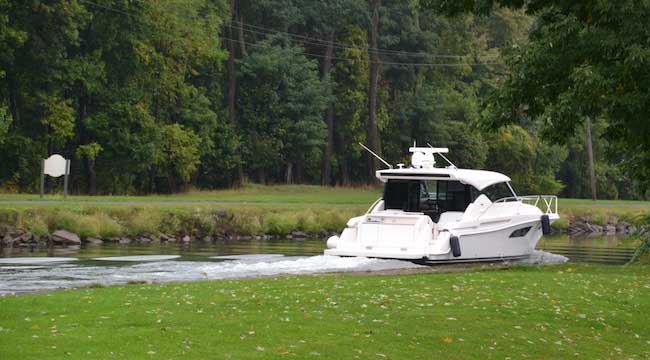DEC, Canal Corporation urge boaters to clean vessels, trailers and gear
State wants to stop spread of round goby, other invasive species

File photo by Tom Rivers: A boater heads east in Albion after passing under the Ingersoll Street lift bridge in this photo from Oct. 2, 2019.
Press Release, NYS Department of Environmental Conservation
The New York State Department of Environmental Conservation (DEC) and the New York State Canal Corporation joined together to remind those planning to visit New York’s waters to “Clean, Drain, Dry” their boats, trailers, fishing gear, and other equipment before recreating in New York’s waters to prevent the spread of aquatic invasive species (AIS).
Starting Friday, May 24, watercraft inspection stewards, also known as boat stewards, will be stationed at more than 220 boat launches and decontamination stations throughout the state to educate and assist the public in cleaning their equipment. Identified by their blue vests, boat stewards can provide a refresher on how to inspect boats and gear and offer information on AIS in New York.
“Since the Watercraft Inspection Steward Program began, boat stewards statewide have conducted more than one million inspections, playing a crucial role in protecting thousands of lakes, ponds, and rivers throughout New York State from invasive pests,” DEC Interim Commissioner Sean Mahar said. “In 2023, boat stewards intercepted more than 11,000 aquatic invasives at boat launches statewide. DEC asks that all boaters Clean, Drain, and Dry before launching to support sustained efforts to protect New York’s waters.”
DEC and the State Canal Corporation continue to implement a comprehensive effort, including a rapid response plan, to combat the potential spread of the invasive round goby to the Lake Champlain Basin following the discovery of the fish in the Hudson River near Troy in July 2021. Aquatic invasive species can out-compete native fish species, disrupting ecosystems and damaging local economies dependent on water recreation and related activities.
Through WISP, a new mobile boat wash decontamination unit will be deployed at launches along the Canal system in the Capital Region this season. The Canal Corporation purchased the unit which contains a hot water pressure washer with a wastewater recovery and filtration system.
Operated by boat stewards, the hot pressurized water will remove AIS from the trailer, hull, anchors, and vessel motor. Internal components of the watercraft (bilge, ballast, lower unit of the motor, and live wells) may also be decontaminated.
New York State Canal Corporation Director Brian U. Stratton said, “As we enter this year’s navigation season, we remain committed to collaborating with DEC and our Canal users to mitigate the potential spread of the round goby and other aquatic invasive species. The new decontamination unit being deployed to Canal system boat launches is one tool in our toolbox to ensure the Canal is resilient for the future. We ask everyone, boaters, anglers, and other water recreational users, to do their part to protect New York’s waterways.”
All water recreationists are advised to follow these steps to help prevent the spread of AIS:
- Clean mud, plants, and animals off boats, trailers, fishing gear, and other equipment (trailer bunks, axles, rollers, lights, transducers, and license plates; motor props; waders; diving gear; anchors; etc.) and discard the material in a trash can or at a disposal station;
- Drain all water-holding compartments, including ballast tanks, live wells, and bilge areas, before leaving an access site;
- Dry everything thoroughly before using boats or equipment in another waterbody. Drying times can vary, but five to seven days in dry, warm conditions is recommended;
- When there’s no time to dry between uses, disinfect boats and equipment with hot water that is at least 140 degrees Fahrenheit or visit a decontamination site;
- Use certified bait that is non-invasive and disease free; and
- Do not dump aquarium contents in any waterbodies, drainage ditches, or sewers.





































































